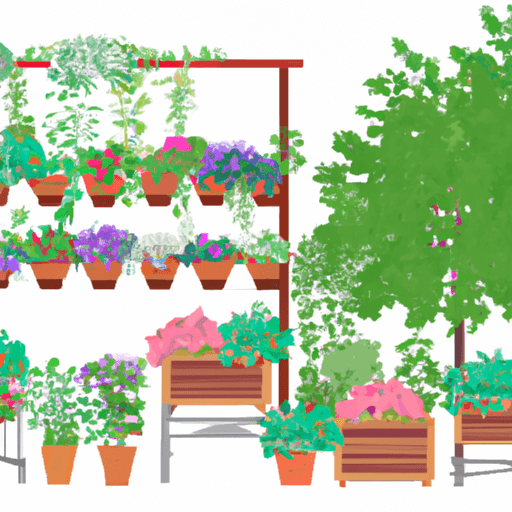Maximizing Your Garden Space focuses on the concept of square foot gardening.
This method divides a garden into small square sections to maximize efficiency and space. It’s suitable for beginners and experienced gardeners, allowing the growth of various vegetables in a small area.
Planning a square foot garden involves considering factors like space size, soil type, layout, and plant choices. Raised beds of 4′ x 4′ dimensions are common, but any size works.
Creating a lattice or grid of one-foot square blocks with string or wire aids in efficient planting.
Choosing the right plants involves considering their size and growth patterns. Regular maintenance, proper watering, and pest monitoring are essential.
Square foot gardening provides a practical solution for maximizing garden space.
Utilizing Vertical Space
Square foot gardening is a great method for maximizing your garden space. By utilizing vertical space with the use of trellises or vertical supports for climbing plants, you can make the most of your available space. Vertical garden structures provide a practical solution for growing plants on walls or other vertical surfaces. This allows you to train plants to grow upwards and free up valuable ground space for other crops. Climbing plants such as tomatoes, cucumbers, and beans thrive when given the support of trellises or vertical structures. These structures can be made from various materials such as wood, metal, or even recycled materials. Not only do they save space, but they also add visual interest to your garden. So, if you’re looking to maximize your garden space, consider incorporating vertical garden structures and enjoy the benefits of growing plants on walls.
Companion Planting for Space Optimization
Interplanting compatible vegetables in a square foot garden maximizes space and deters pests. By utilizing the concept of plant guilds, where different plants support and benefit each other, gardeners can optimize their garden’s productivity.
For example, planting tall, sun-loving plants like tomatoes alongside shorter, shade-tolerant plants like lettuce allows both to thrive without competing for space.
Additionally, intercropping benefits the garden by reducing the spread of pests and diseases. For instance, planting aromatic herbs like basil and marigold can repel pests, while companion plants like beans and corn attract beneficial insects that prey on harmful pests.
Efficient Crop Rotation Techniques
Crop rotation is an effective technique that helps maintain soil fertility and reduce the risk of pests and diseases in a square foot garden. By rotating crops each year, gardeners can prevent soil depletion and pest buildup, resulting in healthier plants and increased yields. Additionally, crop rotation helps to improve compost management by allowing different crops to contribute different nutrients to the soil. Intercropping techniques, such as planting nitrogen-fixing legumes alongside heavy feeders like tomatoes, can further maximize space and nutrient availability.
Here is a table showcasing the benefits of crop rotation and intercropping in a square foot garden:
| Benefits of Crop Rotation and Intercropping |
|---|
| Maintains soil fertility |
| Reduces risk of pests and diseases |
| Maximizes space and nutrient availability |
Creative Container Gardening Ideas
Using various types of containers, such as pots, buckets, or hanging baskets, allows gardeners to experiment with different growing methods and add a unique touch to their gardening space.
One creative idea is to create hanging gardens by repurposing containers. Gardeners can hang pots or baskets from walls, fences, or even overhead structures to make use of vertical space. This not only maximizes garden space but also adds visual interest to the area.
Repurposing containers is another clever way to maximize garden space. Old buckets, cans, or even wooden crates can be transformed into planters, providing a rustic and eco-friendly touch to the garden.
Maximizing Small Garden Spaces
To make the most of limited gardening areas, gardeners can incorporate vertical gardening techniques such as trellises or hanging baskets to add dimension and optimize their plant arrangements. Vertical gardening allows for the utilization of vertical space, making it ideal for small gardens. By growing plants vertically, gardeners can maximize their growing area and create a stunning visual display.
Here are three ways to incorporate vertical gardening in small garden spaces:
- Install a trellis against a wall or fence to support climbing plants like cucumbers or peas, saving valuable ground space.
- Hang baskets from overhead structures to grow trailing plants like strawberries or herbs, adding beauty and functionality to the garden.
- Use vertical planters or pocket gardens to grow a variety of plants in a small footprint, perfect for growing flowers or herbs.
In addition to vertical gardening, raised bed gardening is another effective way to maximize small garden spaces. Raised beds provide better soil drainage and can be easily customized to fit any area. By combining vertical gardening techniques with raised bed gardening, gardeners can create a lush and productive garden in even the smallest of spaces.







